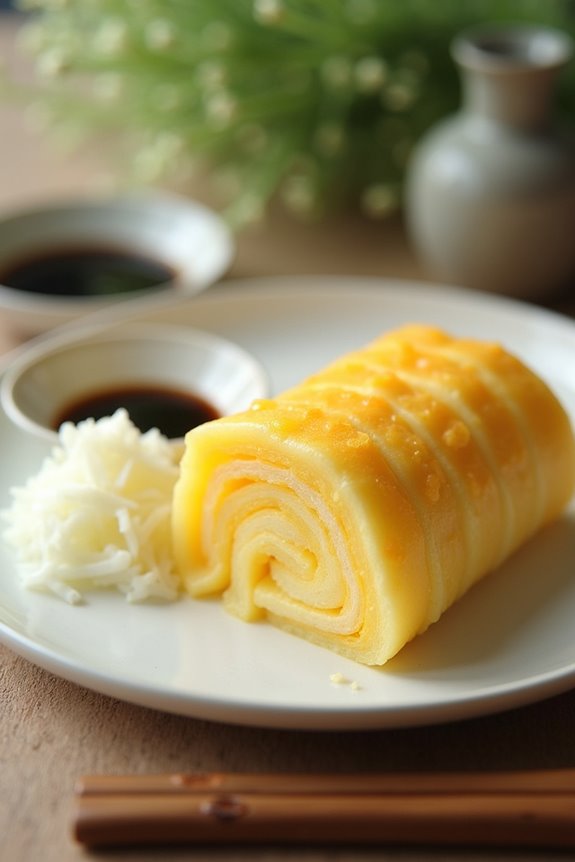When I first attempted making Japanese Tamagoyaki, I vividly remember the chaos in the kitchen—eggs everywhere, a spatula that seemed to have a mind of its own, and me questioning my life choices. But somehow, that little omelette turned out fluffy and perfectly sweet, and I realized it’s all about those layers and love. It’s not just about cooking; it’s about creating moments. So, ready to roll up your sleeves? Let’s plunge into this delightful recipe together!
Why You’ll Love This Recipe
If you’ve ever tasted a perfectly cooked tamagoyaki, you know just how delightful it can be.
Seriously, this Japanese tamagoyaki is pure comfort food. It’s fluffy, slightly sweet, and rolls up like a tasty little gift. Plus, making it yourself is a fun challenge. You might feel like a kitchen ninja, rolling and flipping with finesse.
And hey, if it doesn’t look perfect, who cares? It’ll taste amazing anyway. I still remember my first attempt—let’s just say the results were… unique.
But that’s the beauty of cooking, right? It’s about the journey and the joy of creating something delicious.
Equipment List
When it comes to making tamagoyaki, having the right tools can make a world of difference. First off, you’ll need a tamagoyaki pan, which is a rectangular non-stick beauty.
Sure, you can use a regular non-stick skillet, but it won’t be the same. Trust me; I’ve learned the hard way. A spatula that bends easily will help your rolling game—because let’s face it, mine used to resemble a lumpy disaster.
You might want a whisk; it’s essential for blending those eggs without extra air. Finally, grab a bamboo sushi mat. It’s my secret weapon for shaping the omelette neatly.
In addition to these essentials, consider elevating your culinary experience with a premium cocktail shaker set, as it adds an elegant touch to your kitchen adventures.
I’ve been known to make a mess, so having the right gear really helps keep my kitchen intact.
Our Ingredients
When diving into the world of Japanese cuisine, Tamagoyaki stands out like a beautiful sunrise—bright, inviting, and just waiting to be enjoyed.
There’s something magical about swirling those eggs into a delicate rolled omelette. But before you can experience the joy of taste, you need to gather your ingredients. Luckily, Tamagoyaki is made with just a handful of items that most home cooks should be able to find without launching a full-scale grocery mission.
So, let’s chat about what you’ll need.
- 3 eggs
- 1 tsp soy sauce
- 2 tsp sugar
- 2 tbsp vegetable oil
- Optional: 2 tbsp grated daikon, additional soy sauce for serving
Now, while this list is short and sweet, there are a few things to take into account. Fresh eggs are essential for that fluffy texture, so don’t use the ones that have been lurking at the back of your fridge since last holiday season.
And that soy sauce? It’s your flavor friend—go for a good quality one. The sugar might seem a bit odd for an omelette, but trust me, it adds a subtle sweetness that elevates the entire dish.
And if you want to really impress, grab that grated daikon and some extra soy sauce for serving. Your taste buds will thank you, and so will anyone else lucky enough to share your culinary adventure.
Step-by-Step Instructions

Making Tamagoyaki isn’t just a cooking task; it’s an enjoyable experience that leads to a delightful dish that you can savor at breakfast or even as a snack. Mixing the batter is quick and simple—just follow these easy steps, and you’ll be well on your way to crafting a beautifully rolled omelette that can brighten any meal.
Step-by-Step Instructions
- Whisk the Eggs: Start with 3 eggs in a medium bowl. Whisk them gently, but be careful not to incorporate too much air. We want a smooth mixture, not an airy froth here. Then, add 1 teaspoon of soy sauce and 2 teaspoons of sugar to the eggs. This is where the magic happens—mix it all together until it’s just combined (remember, no vigorous whisking).
- Prepare the Pan: Take your tamagoyaki pan or a non-stick frying pan and place it over medium heat. Add 2 tablespoons of vegetable oil to the pan and let it heat up. You’ll know it’s ready when the oil glistens and swirls around the pan like it’s in a dance competition.
- Pour and Cook: Now, pour a thin layer of the egg mixture into the heated pan, just enough to cover the bottom. Let it cook until the edges are set but the top is still slightly soft—this will take about 1-2 minutes. If you peek, you should see a soft, shiny surface. Don’t overcook it!
- Roll It Up: As soon as the base is set, it’s time to roll. Using a spatula or chopsticks, carefully roll the omelette from one side to the other. This is your first roll, so be gentle; it doesn’t have to be perfect, but do aim for a nice tight roll.
- Repeat the Process: Once rolled, move the omelette to one side of the pan. Time to oil the pan again! Add a bit more oil, then pour another thin layer of egg mixture, making sure it fills the space under your roll. Cook until it’s set again but still soft on top. Then, gently roll the existing omelette onto this new layer.
- Continue Rolling: Keep repeating this process—adding oil, pouring the egg layer, cooking, and rolling—until you’ve used up all the egg mixture. You should have several layers stacked nicely, which gives that signature texture to Tamagoyaki.
- Cool and Cut: Once all the egg mixture has been cooked and rolled, let the Tamagoyaki cool slightly in the pan (just a few minutes). Then, using a sharp knife, cut it into about 6 pieces. Try to slice with a gentle sawing motion to avoid squishing that lovely shape you’ve created.
- Serve with Style: For an authentic touch, serve your beautiful Tamagoyaki with some grated daikon and a splash of extra soy sauce. Trust me, this little addition elevates the whole experience.
Additionally, using premium kitchen gadgets can enhance your cooking experience, making the process even more enjoyable.
And there you have it. Your very own homemade Tamagoyaki, perfectly rolled and oh-so-fluffy. Each slice is bite-sized comfort that satisfies. Enjoy the moment, and maybe even take a moment to appreciate your culinary skills.
Tips & Variations
There’s something truly comforting about a perfectly crafted Tamagoyaki, isn’t there?
To amp up the flavor, I love adding a hint of mirin or even a splash of dashi for that umami kick. If you’re feeling adventurous, try folding in some finely chopped scallions or cooked shrimp—trust me, it’s a game changer.
Don’t worry if your rolls aren’t picture-perfect; I’ve had my share of culinary disasters. Just remember, it’s all about practice.
And hey, using a bamboo sushi mat to shape them can really help, even if it feels a bit fancy.
Once you’ve got the basics down, let your creativity run wild. Life’s too short for boring eggs, right? Enjoy the rolling process—it’s a delicious masterpiece waiting to happen!
How to Serve?
Serving tamagoyaki isn’t just about placing it on a plate—it’s an experience in itself.
I love cutting my beautifully rolled omelette into neat little pieces, each slice showcasing that lovely yellow color. But let’s spice things up. I usually arrange the slices like a little sushi roll, because why not?
I serve it alongside grated daikon, adding a revitalizing crunch. Then, I drizzle a bit of soy sauce on top for that umami kick—delicious. Sometimes, I even like to add a tiny dollop of wasabi, letting my friends guess what I’ve done.
Oh, and you can’t forget the chopsticks; it just feels right. So, why not invite some friends over? This dish isn’t just food; it’s a warm hug on a plate.
Storage & Reheating Guide
After enjoying those delicious slices of tamagoyaki, you might find yourself wondering how to best store the leftovers, if any make it that far.
If you do have some left, here’s what I do: let the tamagoyaki cool completely, then wrap it tightly in plastic wrap or place it in an airtight container. This’ll keep it fresh in the fridge for up to three days. Using airtight food storage solutions can significantly enhance the longevity of your leftovers.
When you’re ready to eat, just gently reheat it in a pan over low heat. No one wants rubbery eggs, right?
I sometimes get impatient and microwave it, but trust me, the pan works wonders. Just a couple of minutes, and you’ll have that lovely, fluffy texture back.
Enjoy every bite!
Final Thoughts
Even though I often find myself getting lost in the intricacies of cooking, tamagoyaki is one of those delightful dishes that can make anyone feel like a pro in the kitchen.
There’s something magical about rolling those eggs, watching them transform into a beautifully layered omelette. Trust me, it’s not as scary as it sounds. With just a little practice, you’ll be flipping and rolling like a seasoned chef.
Plus, your friends will think you’re a culinary genius. And let’s be honest; who doesn’t love impressing guests with something so simple yet elegant?





